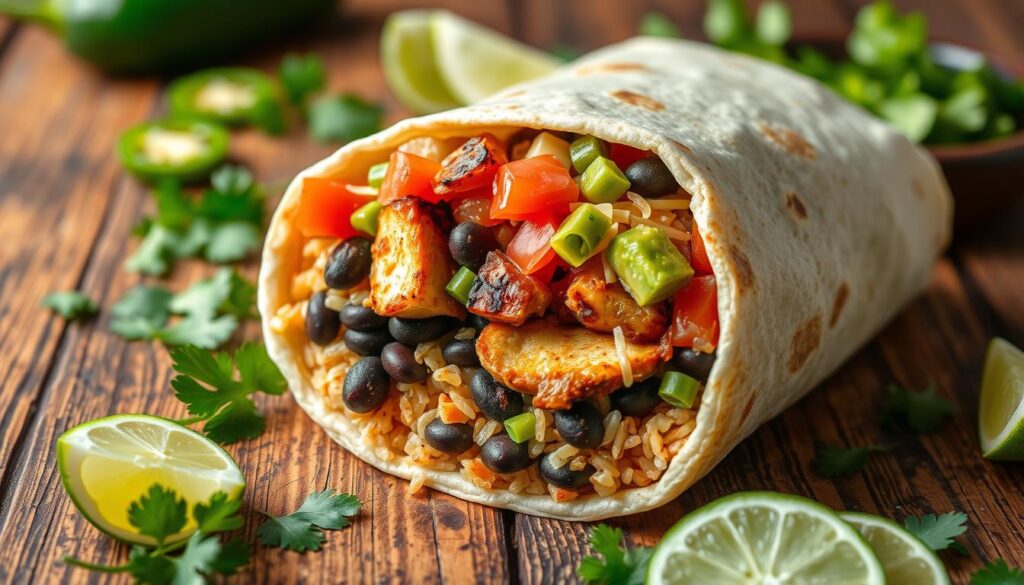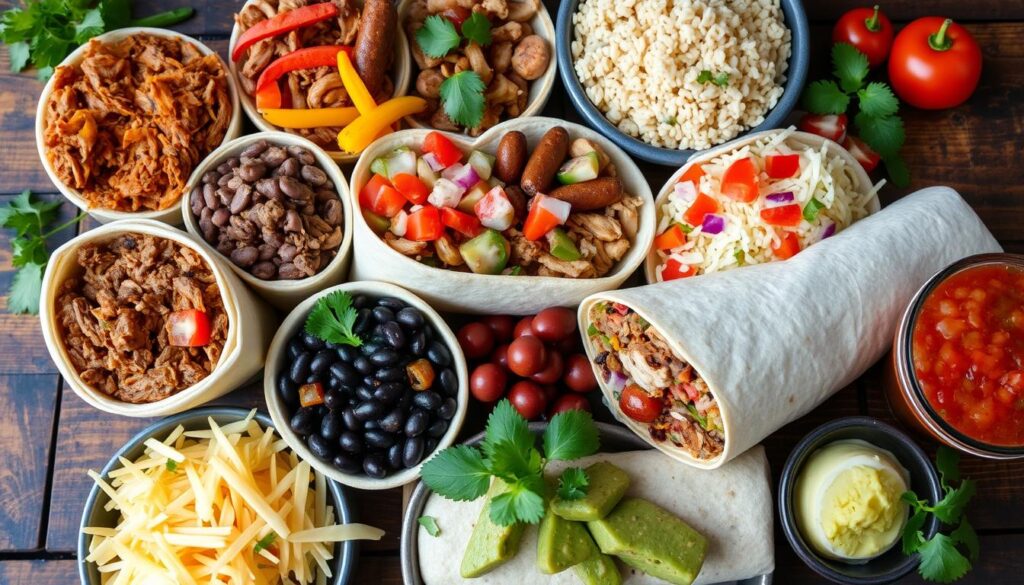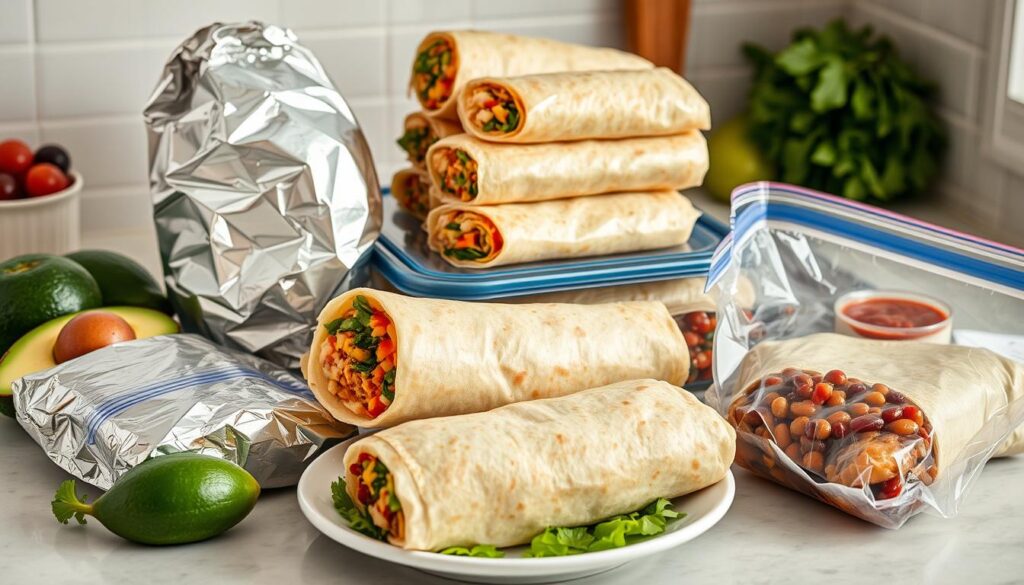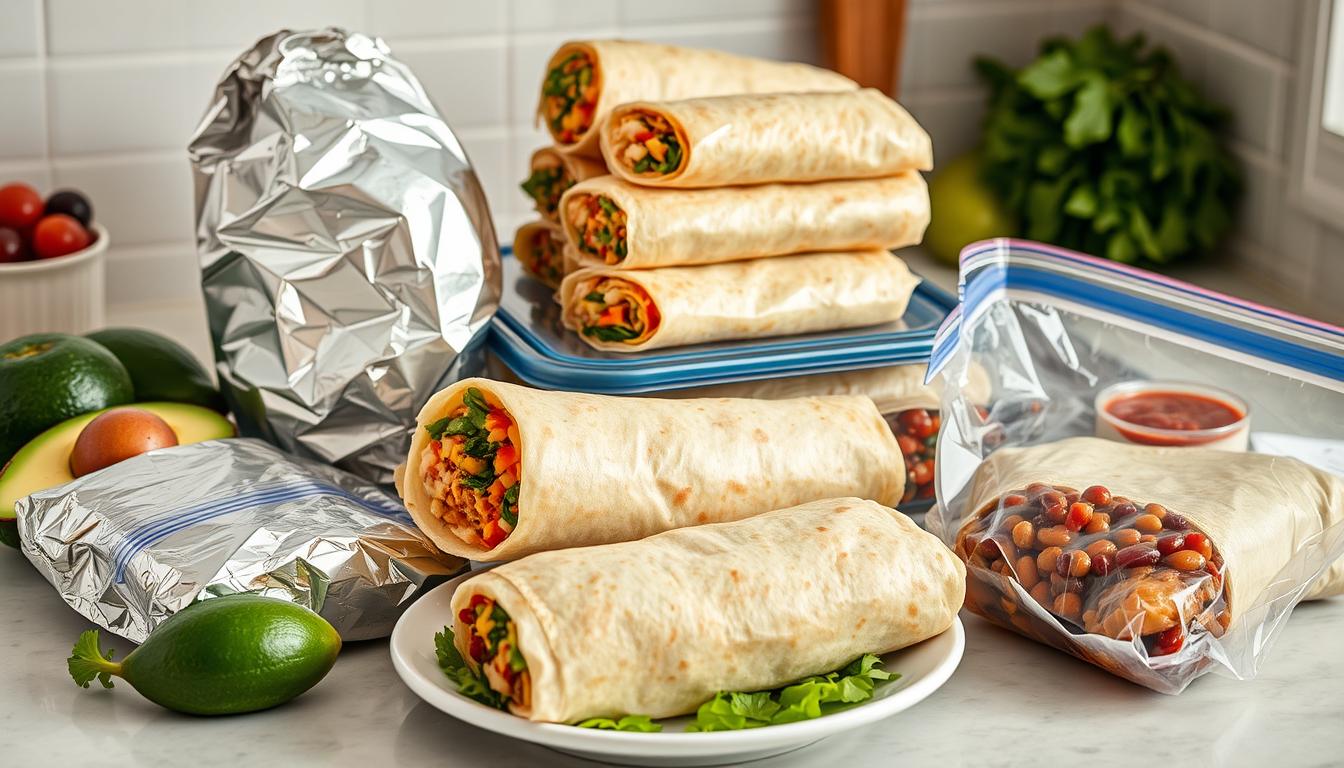
Imagine walking down a lively street in Chihuahua, Mexico. The smell of cooking meats and fresh tortillas is everywhere. The burrito is more than food; it’s a journey that brings people together and fills our bellies.
The burrito has become a worldwide favorite, starting as a simple street snack. In Mexico, burritos are smaller and lighter. But in the US, they’ve grown into big, filling meals. Now, a single burrito can be a whole meal, full of protein, veggies, and tasty flavors.
With fillings like chicken and beef, each bite of a burrito tells a story. It’s a tale of tradition, new ideas, and creativity that knows no borders.
Key Takeaways
- Burritos are a versatile Mexican food with regional variations
- A single burrito can constitute a complete meal
- Fillings range from traditional meats to vegetarian options
- American burritos are significantly larger than traditional Mexican versions
- Burritos represent a cultural culinary experience
Understanding the Origins and Evolution of Burritos
The burrito is more than just a meal. It’s a tasty trip through Mexican food history. This beloved dish has grown from a simple street food to a worldwide favorite, winning hearts and taste buds everywhere.
The Legend of Juan Mendez and His Little Donkey
The term “burrito” means “little donkey” in Spanish. A story says Juan Mendez, a street vendor in Chihuahua, Mexico, used his donkey to carry food. He wrapped ingredients in large flour tortillas to keep them warm, creating the first burritos.
“A simple act of preservation became a culinary revolution” – Mexican Food Historians
From Mexican Streets to Global Phenomenon
Burritos started in Northern Mexico, especially in Sonora and Chihuahua. Important steps in their growth include:
- Early 20th-century Mexican-American migration
- Adding tortilla-based dishes to American food
- Expanding flavors from different regions
Regional Variations and Cultural Impact
The burrito’s story shows Mexico’s rich food traditions. It has changed from small, traditional wraps to big Tex-Mex ones. Each area adds its own touches, making the burrito a global food treasure.
Essential Components of an Authentic Burrito
Making the perfect burrito means knowing its key ingredients. A real burrito mixes fillings that taste great and fill you up. Start by picking top-notch ingredients that go well together.
The heart of a great burrito is its main parts. Let’s look at what’s needed:
- Tortilla: 12-14 inch flour tortillas are the best base
- Rice: About ¼ cup per burrito, cooked in chicken broth
- Beans: 1/3 cup of kidney, black, or pinto beans
- Protein: Choose from four classic meat options
“The secret to an exceptional burrito lies in the quality and balance of its ingredients.”
Meat choices are key in making your burrito unique. Mexican cuisine offers four main protein options:
| Meat Type | Characteristics |
|---|---|
| Carne Asada | Grilled steak, rich flavor |
| Pollo Asada | Grilled chicken, lean protein |
| Al Pastor | Marinated pork with complex spices |
| Carnitas | Slow-braised pulled pork |
Using fresh ingredients makes your burrito stand out. Add pico de gallo with roma tomatoes, onions, and jalapeños. A squeeze of lime juice and some salt can make your salsa pop. This adds a burst of flavor that goes well with the beans and rice.
The Art of Selecting the Perfect Tortilla
Choosing the right tortilla is key to a great wrapped food experience. Your burrito’s success starts with knowing the world of tortillas. These have been a big part of Mexican food for centuries.
Flour vs Corn: The Burrito Champion
Flour tortillas are the best for burritos. They are flexible and can hold lots of ingredients. They are better than corn tortillas because:
- They are more flexible for wrapping
- They have a smoother texture
- They can hold more fillings
- They have a milder flavor that goes well with other ingredients
Tortilla Size and Temperature Mastery
Picking the right tortilla size is an art. A 10-12 inch tortilla is perfect for your dish. The temperature of the tortilla is also very important for its texture.
| Tortilla Size | Best Use | Ideal Warming Temperature |
|---|---|---|
| 8-inch | Small, compact burritos | 100-110°F |
| 10-12 inch | Standard restaurant-style burritos | 120-130°F |
| 14-inch | Large, hearty burritos | 140-150°F |
Warming Techniques for the Perfect Tortilla
Warm your tortilla just before filling for the best texture. Recommended methods include:
- Skillet warming for 10-15 seconds per side
- Quick microwave blast (5-10 seconds)
- Oven warming at low temperature
“A perfectly warmed tortilla is the foundation of an outstanding burrito.” – Mexican Culinary Experts
Classic Protein Options and Preparations

Choosing the right protein is key to making a great burrito. It can turn a simple meal into a memorable experience. Your protein choice can make all the difference.
There are many protein options for burritos, each with its own taste and texture:
- Seasoned ground beef
- Shredded chicken
- Pulled pork (carnitas)
- Grilled steak (carne asada)
- Vegetarian alternatives like beans
Marinating meats can really boost their flavor. For example, carne asada needs marinating to be tender and full of taste.
| Protein Type | Protein Content | Calories | Preparation Time |
|---|---|---|---|
| Ground Beef | 52g | 761 kcal | 30 minutes |
| Shredded Chicken | 42g | 530 kcal | 45 minutes |
| Pulled Pork | 48g | 690 kcal | 2-3 hours |
| Vegetarian Beans | 35g | 450 kcal | 20 minutes |
“The right protein turns a simple burrito into a culinary masterpiece!” – Chef Maria Rodriguez
Vegetarian options are also popular, offering protein-rich choices like black beans and roasted veggies. They’re nutritious and keep the authentic Mexican taste.
Try mixing different proteins to find your favorite burrito filling. Whether you like meat or plant-based options, there’s a great protein out there for you.
Rice and Beans: The Foundation of Every Great Burrito
Rice and beans are key to making a great burrito. They add nutrients, texture, and flavor. This makes every bite special.
Learning about rice and beans can make your burritos better. Let’s explore these important ingredients.
Rice Preparation Techniques
Restaurant chefs know rice is more than just a filler. The way you prepare it changes the taste:
- Spanish rice with tomatoes and Mexican seasonings
- White lime rice with fresh cilantro
- Classic steamed white rice
Bean Varieties and Cooking Methods
Beans are the protein in your burrito. Chefs cook them from scratch for better taste and texture:
- Refried beans with extra seasoning
- Black beans
- Pinto beans
Achieving the Perfect Rice-to-Bean Ratio
Getting the right mix is crucial. Most places aim for:
| Ingredient | Quantity per Burrito |
|---|---|
| Cooked Spanish Rice | 1 cup |
| Cooked Refried Beans | 1 cup |
Mastering rice and bean techniques makes your burritos top-notch. Remember, the secret is in the details and fresh ingredients!
Fresh Ingredients and Toppings That Make the Difference
Make your burrito stand out with fresh ingredients and colorful toppings. The right mix of salsa, guacamole, and fillings can take your dish to new levels. It’s all about the flavors and textures.
Fresh veggies are key to a great burrito. Here are some must-haves:
- Crisp lettuce for crunch
- Diced tomatoes for brightness
- Chopped cilantro for herbal freshness
- Sliced onions for sharp flavor
Salsa adds a burst of flavor to your burrito. Try different kinds to find the perfect match:
- Pico de gallo: Fresh and zesty
- Roasted salsa: Deep, smoky notes
- Salsa verde: Tangy green sauce
Guacamole brings creamy richness. A good guacamole can make your burrito unforgettable.
“The magic of a great burrito lies in its toppings” – Culinary Experts
Remember, use only the freshest ingredients. Your taste buds will love you for it!
Mastering the Burrito Rolling Technique
Rolling the perfect burrito takes skill and precision. The tortilla is your canvas. With practice, you can turn simple ingredients into a tasty masterpiece.
Start your burrito rolling journey by learning the basics. You’ll create a delicious and secure wrapped meal.
Step-by-Step Rolling Guide
- Choose a large, soft flour tortilla, about 12 inches wide.
- Warm the tortilla to 150°F for it to be soft and pliable.
- Put ingredients in the center, keeping a good balance:
- 40% rice
- 30% beans
- 20% meat
- 10% cheese and vegetables
- Fold the sides in to keep ingredients inside.
- Roll from the bottom up, making sure everything is tight.
Common Rolling Mistakes to Avoid
Staying away from these mistakes will help you make a perfect burrito:
- Don’t overfill the tortilla.
- Make sure ingredients are evenly spread.
- Don’t tear the tortilla while rolling.
Tips for Keeping Ingredients Secure
Professional burrito makers suggest these tips:
A well-rolled burrito is an art form that requires practice and patience.
| Technique | Success Rate |
|---|---|
| Consistent rolling practice | 40% improvement after 5-10 attempts |
| Balanced ingredient distribution | 75% reduction in tearing |
| Proper tortilla warming | 60% increased pliability |
With consistent practice, you’ll become a burrito rolling expert in no time!
Storage and Reheating Methods

Keeping your burrito fresh is key. Whether it’s homemade or from a restaurant, the right storage and reheating can make a big difference. This helps keep the taste and texture just right.
Refrigeration and Freezing Guidelines
Here are some expert tips for storing your burrito:
- Refrigerate for up to 3-4 days
- Freeze for up to 3 months
- Cool it down before storing
- Wrap it up to keep moisture in
Reheating Techniques for Perfect Results
There are several ways to reheat your burrito:
- Oven Method:
- Temperature: 350°F
- Time: 12-15 minutes
- Use foil to keep it moist
- Air Fryer Technique:
- Temperature: 350°F
- Time: 5-8 minutes
- Gets a crispy outside
- Microwave Option:
- Time: 1-2 minutes
- Use a damp paper towel to keep it moist
“Proper reheating isn’t just about warming food—it’s about preserving the soul of your meal.”
Remember, don’t let your burrito sit at room temperature for more than 2 hours. By using these storage and reheating tips, your burrito will taste almost as fresh as when it was first made.
Regional Burrito Styles Across America
Start a tasty trip across America’s diverse burrito world. Each area brings its own twist to this favorite dish. From the east to the west, burritos have become local gems, showing off regional flavors and traditions.
Now, let’s dive into some famous burrito styles loved by many:
- San Francisco Mission-Style Burrito: These burritos are huge, as long as your arm, filled with lots of rice and beans
- California Burrito: San Diego’s special burrito has french fries inside
- Breakfast Burrito: First made in Santa Fe, New Mexico, in 1975 at Tia Sophia’s
- Southwest Breakfast Burrito: Filled with eggs, potatoes, and meats
Regional burritos show the creativity of tex-mex food. In Los Angeles, you can find burritos with Korean bulgogi and kimchi. Oregon’s burritos swap french fries for grilled potatoes, adding a local twist.
“A burrito is more than just a meal – it’s a culinary adventure that changes with every region.”
New styles keep popping up, making mexican food in America always exciting. Whether you want a wet burrito from Michigan or a seafood burrito inspired by Puerto Vallarta, there’s something for everyone.
Conclusion
Your journey through Mexican food ends with the burrito. It’s more than a meal; it’s a canvas for creativity and personal touch. Whether making a traditional burrito or trying new fillings, you’ve learned to make simple ingredients into a tasty treat.
Learning about burritos is more than just following a recipe. It’s about the flexibility of this dish, how different places and tastes can change it. You now know how to make burritos that taste like they’re from a restaurant, right in your kitchen.
The burrito shows how food keeps changing. It’s great for breakfast or any event, pleasing many tastes. With what you’ve learned, you can make burritos that are both tasty and special to you.
Your burrito adventure is just starting. Keep trying new things and celebrating the traditions and possibilities of this amazing dish.
FAQ
What is the origin of the burrito?
The burrito comes from Northern Mexico. A famous story says Juan Mendez, a street vendor, made it. He used a donkey to carry his food, and people called it a “burrito” because it looked like the donkey’s bags.
What makes a traditional burrito different from other wrapped foods?
Traditional burritos use a big flour tortilla. It’s softer and bigger than corn tortillas. They fill it with proteins, rice, beans, and toppings, then roll it up into a meal.
What are the most common protein options for burritos?
You can find burritos with seasoned ground beef, shredded chicken, pulled pork, or black beans. Each protein is marinated to add flavor and texture.
How do I properly roll a burrito?
Start with a warm tortilla. Put fillings in the middle, leaving space around the edges. Fold the bottom up, then the sides, and roll it tightly. Make sure it’s tight so fillings don’t fall out.
Can burritos be prepared in advance and stored?
Yes, you can store burritos in the fridge for 3-4 days or freeze them for 3 months. Reheat them in an oven or skillet to keep the tortilla soft. Wrap in foil and heat until warm.
What are some regional burrito variations in the United States?
There are many types. Mission-style burritos from San Francisco are big and full of ingredients. California burritos have french fries. Breakfast burritos in the Southwest have eggs, cheese, and meats.
Are there vegetarian burrito options?
Yes! Vegetarian burritos use black beans, pinto beans, roasted veggies, tofu, and rice. They’re just as tasty as meat ones.
What are the best toppings for a burrito?
Top burritos with fresh salsa, guacamole, sour cream, cilantro, onions, and cheese. These add flavor and freshness.
How do I choose the right tortilla for my burrito?
Choose a large, soft flour tortilla for traditional burritos. Warm it to make it easier to roll. It should be big enough to hold your fillings without tearing.
What’s the ideal rice-to-bean ratio in a burrito?
Use a 1:1 ratio of rice to beans for a balanced burrito. Pick white, Mexican-style, or cilantro-lime rice. Pair it with black or pinto beans for great flavor and texture.

